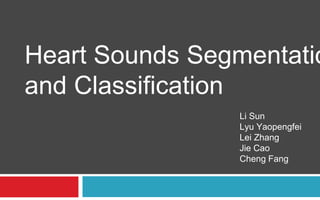
Heart Sound Segmentation and Classification Using Time and Frequency Features
- 1. Heart Sounds Segmentatio and Classification Li Sun Lyu Yaopengfei Lei Zhang Jie Cao Cheng Fang
- 2. Introduction Task: Detect heart disease from heart sound audio. (Clinically meaningful segments: heart muscle contraction S1 and relaxation S2.) Segmentation: heart sound needs to be segmented into components. Find locations and intervals of S1 and S2. Classification: Machine learning techniques instead of medical diagnosis.
- 3. About Data From the Classifying Heart Sounds PASCAL Challen Four categories: • Normal: it contains the normal human heartbeat sound with only S1 and S2. • Murmur: there is a noise between either S1 and S2 or S2 and S1. They can be a symptom of many heart disorders. • Extra Heart Sound: there is additional sounds between either S1 and S2 or S2 and S1. In some situations it is an important sign of disease. • Artifact: there are a wide range of different sounds. Different length, between 1-10 seconds
- 4. Classification pipeline Signal Preprocessing De-noise by wavelet decomposition. Shannon energy representation Feature selection Time Domain and frequency domain. Classification Challenges: 1. noisy background. 2. S1 and S2 identification. 3. appropriate features selection SVM, Random forest.
- 5. Signal Preprocessing De-noise by wavelet decomposition Representing signal by Shannon energy
- 6. Time Domain Features We use k-means to classify the projection in Y axis of the de-noised signal.
- 7. Extract Cardiac Cycle by Autocorrelation A cardiac cycle time is a whole period of one human heart sound include S1-S2 and S2- S1 Time Domain Features
- 8. 1. Get local minimum and maximum by check for derivation equal 0. 2. Get peaks by the rules of this sequence (min, max, min). 3. Obtain peaks tranigle areas. 4. Thresholding the areas 5. 2 or 3 peaks only in each cardiac cycle. Extract S1 S2 locations by Salman’s method Time Domain Features
- 9. Representing these features 1. Obtain the time differences between S1 and S2 locations. 2. Due to the differences all lies within 0- 1s. 3. Using a 20 bins histogram to representing it by a 1*20 vector within range 0-1s. 4. Plus a “mean”and “standard deviation” of the time differences in the end of the vector to make it more sufficient as a 1*22 vector. Time Domain Features
- 10. Frequency domain segmentation Each special class heart sound represents the similar frequency spectrum distribution. It make sense that frequency distribution could be a feature for classification
- 11. Using Fourier transform Segmenting one heart sound to 20 parts Compute sum of each part Frequency domain segmentation
- 12. Bag of Visual Word methods Time domain features Time domain features: 1. Shannon energy (time) 2. Histogram (time) Classifier: SVM(one vs one) BoVW: 1. Divide features into N segments with same length. 2. Construct a dictionary 3. Use this dictionary to describe each sample
- 13. Frequency and time domain features 1. De-noise original signal by wavelet, then Fourier transform. (frequency) 2. Shannon energy (time) 3. Histogram (time) Classifier: SVM(one-vs-one) Conclusion: • Combining frequency and time domain information could improve performance of classifier very little. • The value of dictionary size is not significant.
- 14. Results and conclusion The best correct rate we can get is about 70% - 75% obtained by using 10 dimension combined features with random forest classification method.
- 15. Thank you Reference: [1]P. Bentley, G. Nordehn, M. Coimbra, and S. Mannor, “The PAS- CAL Classifying Heart Sounds Challenge 2011 (CHSC2011) Results,” http://www.peterjbentley.com/heartchallenge/index.html. [2] Y. Deng and P. J. Bentley, “A robust heart sound segmentation and classification al- gorithm using wavelet decomposition and spectrogram,” Extended Abstract in the First PASCAL ..., 2012. [3] A. H. Salman, N. Ahmadi, R. Mengko, A. Z. R. Langi, and T. L. R. Mengko, Automatic segmentation and detection of heart sound components S1, S2, S3 and S4. IEEE, 2015. [4] D. Gradolewski and G. Redlarski, “Wavelet-based denoising method for real phonocar- diography signal recorded by mobile devices in noisy environment,” Computers in biology and medicine, vol. 52, pp. 119–129, Sep. 2014. [5] H. Liang, S. Lukkarinen, and I. Hartimo, “Heart sound segmentation algorithm based on heart sound envelogram,” in Computers in Cardiology 1997. IEEE, 1997, pp. 105–108. [6] S. Debbal and F. Bereksi-Reguig, “Computerized heart sounds analysis,” vol. 38, no. 2, pp. 263– 280, 02 2008.
Notas do Editor
- in some situations it is an important sign of disease.
- Thanks xxx, in this part, I will introduce the frequency domain segmentation or we can call frequency domain feature extraction. We believe that every sound consists of different frequency signals. But, the same class heart sound represents the similar frequency distribution, So we consider that frequency could be a feature for the classification. You can see these three parts of the picture shows the three classes heard sound’s frequency distribution. Extrhals looks distribute on the middle of the spectrum, murmur looks distribute on around 50 Hz, and normal looks focuse on 75 Hz. So, how can we extract the useful features from a series of frequency signals.
- In here, we try to segment the frequency to N part with frequency, for example we set 0-15 Hz as first part, 15-30 Hz as second part, and so on. This picture shows that a murmur heart sound signal is segmented to 20 parts. And after that, we get the sum of the each part as one dimension of the frequency feature. So in the end, we can get a feature with 20 dimension number from one heart sound. And put this feature to training. It’s sounds reasonable.